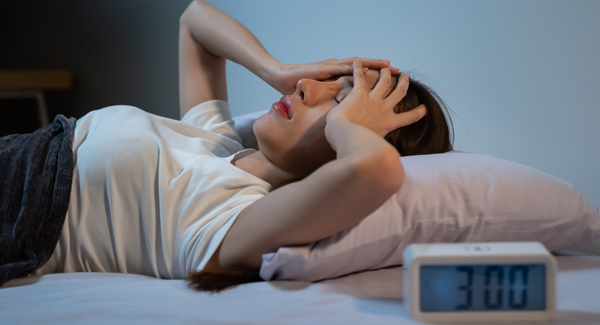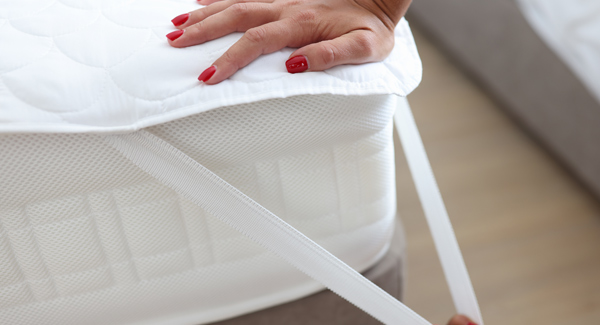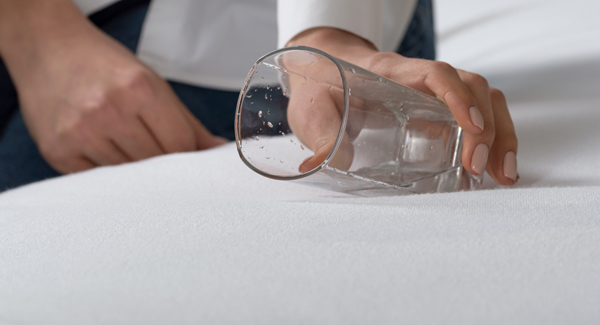Home » Bedding advice » Do Mattress Protectors Make You Hot?
Do mattress protectors make you hot?
Article navigation
- Published:
- Written by: Tony Brown
- Topic: Bedding advice
Your choice of bedding can have a significant impact on your sleep quality. Breathable bedding can help regulate your body temperature, creating a cool and comfortable sleep environment. On the other hand, synthetic materials can trap heat, leading to overheating and discomfort.
Using a mattress protector prevents liquids from penetrating your mattress. However, some mattress protectors, especially those with a polyurethane layer, may retain heat and influence your body temperature in bed. This can be uncomfortable if you are a warm sleeper or sweat in bed.
Why does a mattress protector make you feel hot?
There are several reasons why a mattress protector might make you feel warm at night.
Materials
The materials the mattress protector is made from can influence your body temperature. Many mattress protectors are made from synthetic materials like polyester and spandex. While these materials are affordable, they tend to trap body heat and are not moisture-absorbent, making you feel warm and uncomfortable in bed
Waterproofing
Waterproof mattress protectors often have a plastic backing material that prevents liquids from penetrating the mattress. However, while providing an effective waterproof barrier, they might restrict airflow and prevent heat from escaping, causing some people to feel hot and clammy.
Material thickness
Even though most mattress protectors are thin, thicker ones, like those with quilted layers, trap more body heat because they offer better insulation.
What mattress protectors are suitable for those who sweat?
For those who tend to sweat at night, choosing a lightweight, breathable, and moisture-wicking mattress protector can help keep the sleeping surface cool and dry.
Bamboo
Bamboo is a strong and durable material that is incredibly soft. It is highly absorbent and breathable, making it ideal for those who get hot in bed. Bamboo is kinder to the environment as it does not require harmful chemicals, fertilisers or pesticides during growth. It is naturally hypoallergenic and anti-bacterial, making it suitable for those with allergies and sensitive skin.
Cotton
Cotton is a soft and durable material that is gentle on the skin. It is fully breathable and allows air to circulate through the material, making it ideal for bedding. Cotton is also naturally hypoallergenic and less likely to cause allergic reactions.
Silk
Silk is renowned for its exceptionally soft and luxurious feel. It is naturally hypoallergenic and resistant to dust mites, moulds and mildew, making it ideal for those with allergies and sensitive skin. Silk bedding naturally regulates body temperature, keeping you cool in the summer and warm in the winter.
Tencel
Tencel is made from sustainably sourced wood pulp using eco-friendly practices. It is highly absorbent and breathable, keeping you cool and dry in bed. Tencel has a soft and comfortable texture that is suitable for sensitive skin.
Can you sleep without a mattress protector?
Although mattress protectors are optional, using one will help ensure a clean, hygienic and comfortable sleeping environment. A good-quality mattress cover protects your mattress from stains and spillages. Without one, liquids can penetrate the mattress, damage the components and provide the perfect conditions for mould and mildew.
A mattress protector can also protect against allergens and help extend the life of the mattress by preserving its condition.
How to create a cooler sleep environment
Maintaining a comfortable bedroom temperature is essential for ensuring good-quality sleep. The ideal bedroom temperature for sleep is between 60 and 67 degrees Fahrenheit (15.5 to 19.5 degrees Celsius). However, feeling too hot in bed can make you sweaty and uncomfortable and disturb your sleep. Fortunately, there are some steps you can take to keep you cool and comfortable in bed.
Keep your bedroom cool
Lowering the bedroom temperature by a few degrees can help you feel cooler at night. Open the windows and doors if necessary to allow cooler air into the room. But close the windows and draw the blinds and curtains during the day to block out the sun. You could also use an electric fan to help circulate air.
Use light and breathable bedding
Opt for lightweight, breathable bedding made from natural materials like bamboo and cotton. Consider removing blankets and extra layers and opting for a lower tog duvet or a flat sheet.
Switching to a thinner mattress protector will protect your mattress without impacting its feel and performance. It will also help keep the sleeping surface cooler.
Sleepwear
Choosing the right sleepwear can help you feel cool and comfortable at night. Like your bedding, opt for lightweight, breathable and moisture-wicking materials, such as cotton and silk. If you’re still too warm, consider sleeping in just your underwear.
Change your mattress
Your choice of mattress may be causing you to overheat. Memory foam, for example, closely conforms to the body and tends to retain heat, making you warmer in bed. Cheaper mattresses often contain synthetic materials, which are typically less breathable and absorbent than natural fillings.
Consider changing your mattress, especially if it is a few years old. Opt for mattresses with cooling features or materials that are breathable and moisture-absorbent. Sharing a bed with someone can increase your body temperature. Upgrading to a bigger bed or sleeping in separate beds can help.
Food and drink
Drink plenty of water throughout the day to remain hydrated. Avoid consuming caffeine or alcohol, as they can make you feel dehydrated and disturb your sleep. Also, avoid eating a large meal or spicy foods before bedtime, as they can affect your digestion and sleep quality.
Take a cold shower or bath
Take a cold shower or bath before bedtime to lower your bed temperature and make it easier to fall asleep. You could also wipe yourself down with a wet towel.
Final thoughts
Mattress protectors made from non-breathable materials can make you hot. If you’re a hot sleeper or are concerned about heat retention, opt for a lightweight and breathable mattress protector. Remember, a mattress protector protects your bed from stains and spillages. Your mattress can quickly deteriorate without one, so using one is better than not at all.
References
https://www.webmd.com/sleep-disorders/ss/slideshow-sleep-cooler
https://bedadvice.co.uk/10-tips-on-how-to-cool-down-a-room-at-night/
Share this article

About the author
Tony Brown is the founder and creator of The Bed Consultant. His career in the bed industry began in 2002. After graduating from university with a degree in Business Administration, Tony joined one of the largest independent furniture retailers in the UK as a bed consultant. Tony has helped thousands of customers find the perfect mattress.



